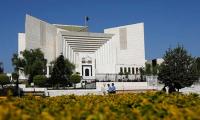On March 4, 1967, hundreds of students of the Sindh University (SU) and neighbouring academic institutions had made a growing movement against the dictatorship of General Ayub Khan stronger. On that day, the martial raw regime responded with brutality to stop the protest on its way to Hyderabad, injuring 17 students and arresting over 200. But the struggle of that day had given Sindh a new beginning of politics.
After 53 years, prominent academic and researcher Prof Aijaz Ahmed Qureshi has made an effort to document the historic student movement by compiling a book titled ‘March 4 and struggle of Sindh students’.
On Wednesday, the book was launched in a well-attended event at the Arts Council of Pakistan, where leaders of the student movement spoke about the 1967 campaign and its impact against the One Unit and the dictatorship of Ayub Khan. The book is bilingual – Sindhi and English.
The speakers included Qureshi, Barrister Mujib Pirzado, a senior lawyer, Yousaf Laghari, former advocate general, Masood Noorani, former additional advocate general, Dr Suleman Shaikh, Dr Kamil Rajper, Madad Ali Sindhi and Fazal Suleman Kazi. Senior journalist Dr Ayoub Shaikh moderated the event.
A large number of people, especially students, attended the book launch to pay tributes to the then student leaders, who are now senior citizens. Speakers said that the movement was a symbol of struggle against dictatorship and for the rights of Sindh and inspired people.
They said that the protests were a peak of the unrest among Sindhi students that had been simmering beneath the surface for a long time against One Unit. Its causes went deep into the humiliations suffered by Sindh and its people on cultural, political, administrative and economic levels, they said.
Politically and administratively, One Unit meant that Sindh disappeared as an entity and was reduced to looking to the capital Lahore for the pettiest matters, they added.
Qureshi said March 4 signified a vigorous movement and recalled how thousands of students used to take to the streets. “As a result of this agitation, Ayub Khan had to abolish One Unit, said Qureshi, who had recently co-authored a pioneering work on Sindh’s economy.
During Ayub Khan’s dictatorship, divisional commissioners were more powerful than the ministers. They were all-powerful and behaved like kings in their divisions.
On March 4, 1967, the university students, irked by the transfer of Sindh University vice-chancellor Hassan Ali Abdul Rehman and appointment of then commissioner of Hyderabad Masroor Ahsan in his place, took out a procession from the campus to Hyderabad in eight buses, Qureshi said. “While the procession was on the Jamshoro-Hyderabad road, police unleashed brutal force against the protesters.”
Qureshi said that the movement continued until 1969 when Ayub Khan’s region was eventually brought down.
The book consists of pieces mainly written by speakers at the event. Other pieces are of Shaik Ayaz, Rasool Bux Palijo, Abdul Wahid Aresar, Aijaz Mangi, Mushtaq Mirani, Sohail Sangi, Abdul Wahid Soomro, Sher Muhammad Kalwar, Dr Bakht Jamal Shaikh and Gulshan Laghari.
FAST National University of Computer and Emerging Sciences Karachi campus seen in this image. —...
Karachi Mayor Barrister Murtaza Wahab addresses a press conference at the Sindh Assembly building in Karachi, on May...
This collage shows missing student Mustafa Amir and torched vehicle from which his body was recovered. —...
A representational image of a police tape restricting an incident scene. — Reuters/FileA man was killed and another...
Corps Commander Karachi Lieutenant General Muhammad Avais Dastgir presents an award to a trainee during the passing...
The representational image shows the blood sample taken for test. — AFP/FileThe Mirpurkhas district in Sindh is...







